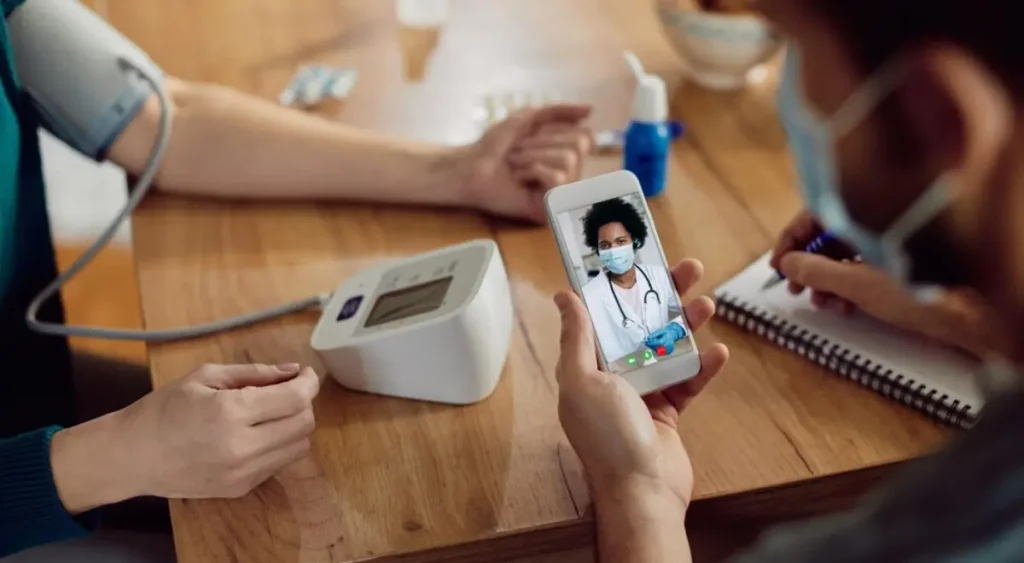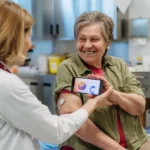Remote Patient Monitoring (RPM) For Blood Pressure Management: How It Works?

With fluctuating blood pressure or hypertension affecting 1.2 billion adults globally, finding improved ways to manage this common chronic condition is important. Though routine medication can help regulate the high blood pressure, patients usually struggle to maintain appropriate readings in between medical appointments.
Remote blood pressure monitoring plays a significant role in improving the hypertension symptoms and provides timely intervention, just in case. It allows healthcare providers in getting real-time insight into patients’ health data and focuses on minimizing hospitalizations with remote blood pressure care.
Table of Contents
ToggleRisks Associated with Hypertension/ High Blood Pressure
In the United States, 47%, or almost 116 million individuals, have hypertension. It is an underlying risk factor for several chronic diseases, such as:
- Heart attack
- Heart failure
- Kidney disease
- Stroke
- Vision loss
- Sexual dysfunction
One of the simplest strategies to prevent the onset of above listed chronic conditions is to measure blood pressure on a regular basis. With Remote patient monitoring (RPM) software and connected blood pressure monitor physicians can access patients’ readings anytime, anywhere and hence it becomes highly convenient not just for the patients but for the physicians too who now have 24/7 access to the vitals and can intervene if they observe abnormalities or warning signs. e.
Barriers to Hypertension/ Blood Pressure Monitoring
While hypertension can be controlled effectively, there are many barriers that hinder easy and efficient BP management in patients, including:
- Inadequate or inconsistent blood pressure measurement tools
- Having masked hypertension with normal blood pressure at office but high at home
- Clinical inertia that happens when steps aren’t taken to control blood pressure
- Lack of evidence-based treatment and self care in patients
RPM can help with each of the barriers described above. It can assist patients in developing a daily BP measuring habit and accurately recording their readings on the devices.
Coming to the providers, RPM provides data-driven insights into the patient’s blood pressure trends over time and allow healthcare providers in making informed decisions. RPM software for blood pressure management allows clinicians to receive real-time alerts and make timely interventions when a patient’s blood pressure reading is concerning.
Who Can Benefit from Remote Blood Pressure Monitoring?
Hypertension develops gradually and can be prevented by eating a balanced diet and exercising regularly. Being in a busy routine, it can be challenging for patients to make such lifestyle adjustments. This is where remote blood pressure monitoring comes into play. It can assist in monitoring hypertension patients and high risk individuals, including:
- Individuals over 65
- Pregnant women
- Patients having a family history of high blood pressure
How Do Remote Blood Pressure Monitoring Work?
Remote blood pressure monitoring is a digital breakthrough in the healthcare sector that utilizes a remote patient monitoring (RPM) platform and FDA-approved remote patient monitoring devices to track vital signs.
Patients can take their BP readings at home and must use their device for at least 16 days, each month. The blood pressure monitor automatically transfers the readings to the digital health platform and the clinician can use the dashboard to view the data and make interventions, if needed.
Not only this, clinicians can receive timely alerts and a notification alert is generated when a patient’s readings surpasses the specified limitations.
4 Ways RPM Can Work For Blood Pressure Management
- Regular BP monitoring: RPM helps patients in recording their blood pressure throughout or anytime of the day as recommended by the clinician.
- Medication reminders: Patient receives medication reminders to ensure he/she follows their medication plan for better outcomes.
- Symptom assessment: Patients share insight into their symptoms to helps a clinician analyze the underlying blood pressure trends.
- Virtual visits: RPM allows a patient and clinician to communicate in real time if a blood pressure reading is out of range.
Benefits of Remote Blood Pressure Monitoring For Patients & Providers
Remote blood pressure monitoring is beneficial for both patients and healthcare practitioners and extends beyond in-clinic visits. Some common benefits of RPM for hypertension or high blood pressure include:
- Better healthcare between clinical visits
Patients can regularly assess their blood pressure from the comfort of their own homes using a remote blood pressure monitoring device. Frequent measurements provide clinicians with a clear picture of any fluctuations in the patient’s blood pressure levels and alter the treatment, if needed.
- Increases patient engagement & outcomes
Remote blood pressure monitoring makes people feel more involved in their health and encourages active participation. The majority of cellular RPM devices are simple to use and are shipped directly to the patient.
Remote blood pressure monitoring helps patients in collecting their blood pressure measurements and allows care providers in constantly assessing their patient’s health and alter treatment plans likewise.
- Reduces healthcare costs
High blood pressure costs the healthcare industry hundreds of billions every year. Early detection of hypertension symptoms, along with the right treatment and care can greatly help in saving money on emergency room visits, testing, procedures, and hospitalizations.
- Generates more revenue for healthcare providers
Remote blood pressure monitoring enables healthcare professionals to serve more patients by making healthcare more accessible. Patients no longer have to worry about the doctor appointments, wait time, and transportation costs. In a similar way, healthcare providers can access more patients and from anywhere they feel convenient. More patients mean more revenue. Clinicians are reimbursed for the time spent on remote healthcare activities, such as patient data review and billing using RPM CPT codes: 99457 and 99458.
HealthArc Makes Remote Patient Monitoring A Seamless Experience
HealthArc’s all-in-one remote patient monitoring software helps practices connect to their patients, optimize reimbursement and minimize documentation with increased clinical efficiency. With our HIPAA compliant platform, communicate with patients via audio-video calls, SMS, make care plans available to the patient, re-fill prescriptions, review diagnostics and make referrals.
HealthArc offers seamless integration with all leading EHRs through HL7 and FHIR capabilities to manage patients dealing with any type of chronic conditions. To know more about our RPM software, book a free demo now or feel free to talk to our team at +201 885 5571 for more details.
Frequently Asked Questions (FAQs)
RPM for blood pressure management uses connected blood pressure monitors and a cloud-based platform to track patients’ readings outside of the clinic. It enables clinicians to view data in real time, detect abnormal trends, and intervene ahead of complications.
Because hypertension affects a large portion of the population and contributes to serious conditions (heart attack, stroke, kidney disease), RPM bridges the gap between clinic visits and empowers continuous monitoring, early intervention, and better outcomes.
Individuals with hypertension or who are at high risk (e.g., older adults, pregnant women, or those with a family history) may particularly benefit. It’s especially useful for people who struggle to measure BP consistently or have masked hypertension.
Barriers include inconsistent use of measurement tools, masked hypertension (normal in office but high at home), clinical inertia (lack of action), and insufficient self-care. RPM helps by automating readings, sending alerts, and enhancing patient engagement.
A patient uses an FDA-approved connected device at home; the device uploads data to a secure platform (often via cellular or Bluetooth). The clinician reviews the readings via dashboard; alerts are generated for out-of-range values; virtual check-ins and care plan changes follow.
Features include regular BP readings from home, medication reminders, patient symptom assessments, and virtual visits when needed. These help maintain oversight between clinic visits.
For patients: better monitoring from home, greater engagement, and fewer complications/hospitalizations. For providers: access to real-time data, more efficient workflows, and potential for expanded reach and reimbursement.
Typically, RPM uses FDA-cleared digital blood pressure cuffs, either cellular or Bluetooth enabled, that automatically transmit readings to the clinician’s dashboard, eliminating the need for manual entry.
Yes. Virtual visits are often triggered when the system alerts to an out-of-range reading, allowing the clinician and patient to connect remotely, review data, adjust treatment, or reinforce lifestyle/medication instructions.
By enabling early detection of abnormal BP trends, avoiding ER visits or hospital admissions, and improving medication adherence and engagement, RPM reduces the economic burden of unmanaged hypertension.
Requirements include selecting the right connected device, educating patients on home use, ensuring automatic data transmission, setting up clinician dashboards and alerts, and establishing workflows for virtual follow-up and care adjustments.
Yes. A robust RPM platform often supports integration (via HL7/FHIR) into EHR systems, enabling seamless documentation, alerting, and care coordination across providers.
The article notes patients are often asked to use their BP monitor for at least 16 days per month as part of the program to comply with monitoring standards and capture meaningful data trends.
The system generates an alert to the clinician; the care team may reach out to the patient via virtual visit or message; adjustments to medications or lifestyle may be made; and a follow-up plan is executed.
Yes—for RPM services generally (including those monitoring BP), there are CPT codes such as 99457 and 99458 (for clinical data review & management) and others for device setup/monitoring. The article references these as parts of the value proposition for providers.
Most Recent Blogs
Categories
Related Blog
- October 23, 2025 | Read Time: 12 mins
How RPM Devices Improve Hypertension and Diabetes Outcomes in Medicare Populations
Remote patient monitoring (RPM) is transforming chronic care for Medicare beneficiaries. CMS...
Learn More- August 25, 2025 | Read Time: 13 mins
How Can “One Big Beautiful Bill” Boost RPM Programs by $50B?
The “One Big Beautiful Bill,” signed July 4, 2025, directs $50B over...
Learn More- August 22, 2025 | Read Time: 17 mins
HealthArc Platform vs RPM Software Solutions
Is your healthcare organization trying to pick a remote patient monitoring solution?...
Learn More


